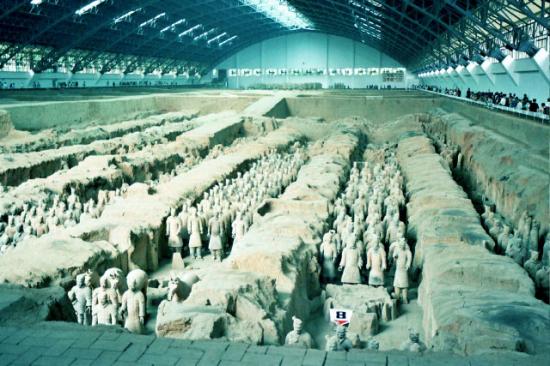Source - http://www.sci-news.com/archaeology/article00700.html
A new analysis of the Terracotta Army, a famous collection of clay sculptures depicting the army of the first Chinese emperor Qin Shi Huang (259 – 210 BC), has revealed that the craftsmen responsible for working on bronze weapons of terracota warriors followed a sophisticated labor model now associated with the world’s largest car manufacturer, Toyota.

The approach, sometimes referred to as Toyotism, involves using small workshops of highly skilled engineers, capable of producing any model of car as and when it is needed, rather than a production line where each unit concentrates on making individual components.
A team of scientists, led by Dr Marcos Martinón-Torres of the University College London’s Institute of Archaeology, had inspected more than 1,600 arrow heads of the Army and, finding them identical to the naked eye, assumed they had come from a single, large-scale production line.
However, when the researchers analyzed the chemical composition of the bronze used to make the arrow heads they found that each quiver-full was made individually with a single batch of bronze being melted in a crucible, without any mixing of batches.
The findings, published in the Journal of Archaeological Method and Theory, confirm the extraordinary level of skill and versatility of the craftsmen who created the Army’s weapons.
“The first Emperor Qin Shi Huang, who commissioned the Terracotta Army and the rest of the city-sized mausoleum at Xi’an before he died, was obsessed with standardization and introduced standard units of measurement, currency and script. He must have demanded very exact standards for the Terracotta Army’s weapons because their level of accuracy is comparable to that of modern mass-produced items,” Dr Martinón-Torres explained.
“It is amazing that these arrow heads are so similar – identical to the human eye – yet chemical analysis shows they came from separate production units that would have produced each entire quiver with all of its parts: from the bronze head through the bamboo shaft and up to the feathers.”
“We now believe that the craftsmen who made them also constructed the swords and other equipment the soldiers carry, and that a cellular production system was also employed for the warriors themselves. These craftsmen must have been very skilled and versatile to be able to make such a wide variety of items, yet complete each one to such precise standards.”
Dr Martinón-Torres added that “although the Toyotism-style approach would likely produce weapons and other equipment at a slower rate than a standard assembly line, in the case of constructing the Terracotta Army it may have been more efficient.”
“When you are making the world’s first Terracotta Army, you are unlikely to know exactly how many of each item you will need – particularly when the specifications are so high that some parts may not meet them and will have to be recast. The Toyotism approach allows your craftsmen to switch to producing the parts that are needed when they are needed.”
“In addition, the Army’s soldiers are arranged in such a tight formation in the mausoleum that only the front row could be worked on at any given time. If a single production line had been used the entire process would have to stop every time a single worker failed to keep up with the others. The Toyotism approach avoids this hazard – if something is urgently needed to finish a soldier, one of the workshops can stop whatever it is doing and quickly create this one part.”
To make such similar weapons the craftsmen employed what were then cutting edge manufacturing techniques. The team found parallel, microscopic scratches on the blades, indicating that they had been sharpened on a wheel, rather than with a hand held tool. This makes the Terracotta Army’s forty thousand weapons the first known blades to be sharpened with a wheel.
Bibliographic information: Marcos Martinón-Torres et al. 2012. Forty Thousand Arms for a Single Emperor: From Chemical Data to the Labor Organization Behind the Bronze Arrows of the Terracotta Army. Journal of Archaeological Method and Theory, published online before print; doi: 10.1007/s10816-012-9158-z